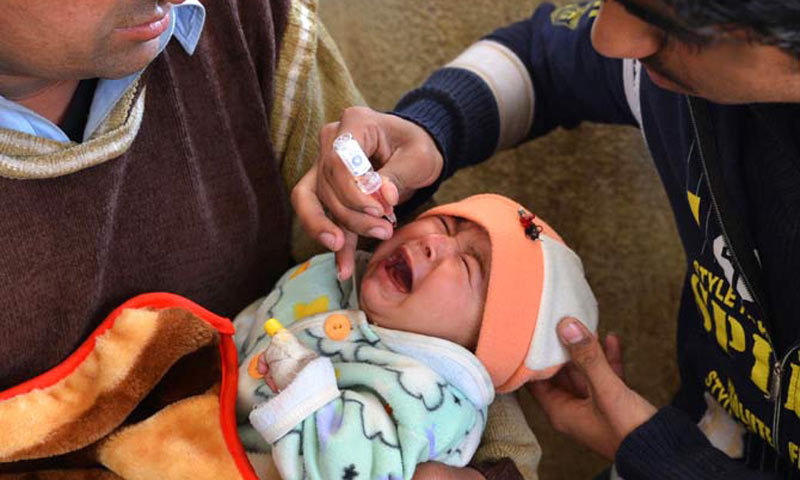Afghanistan, Pakistan and Nigeria are those hapless nations in which the maledictions of Poliovirus are yet to be eradicated. This is a matter of great concern which must be solved by brains and brawn of international community.
[contentblock id=1 img=adsense.png]
Found in 1908 by Karl Landsteiner, the Poliovirus has exposed itself in three serotypes throughout the globe inter-alia PV1, PV2 and PV3. PV1 is the most commonly encountered form and the one most closely associated with paralysis.
The virus is transmitted via the fecal-oral and oral-oral routes. The cells of the pharynx and intestinal mucosa are the first ones to be infected with poliovirus. It gains entry to the cells by binding to the poliovirus receptor (PVR) or CD155 on the surface of the cell membranes. The virus then hijacks the host cell’s own machinery and begins to replicate. Poliovirus divides with in gastrointestinal cells for a week, from where it spreads to the tonsils, the intestinal lymphoid tissue including the M cells of Peyer’s patches, the deep cervical and mesenteric lymph nodes. The virus is subsequently absorbed into the bloodstream and causes viremia. In 1% of infections, the virus gains access to the Central Nervous System (CNS). Most patients with CNS involvement develop non paralytic aseptic meningitis with symptoms of headache, neck stiffness, abdominal and extremity pain, fever, vomiting, lethargy and irritability. About one to five in 1000 cases progress to Acute Flaccid Paralysis syndrome.
[contentblock id=2 img=gcb.png]
Depending on the site of paralysis, Paralytic poliomyelitis is classified as spinal, bulbar or bulbospinal. The laboratory confirmation can be carried out by finding poliovirus in a stool sample and swab of the pharynx. Other investigations include serum antibodies against the poliovirus and detection of virus in cerebrospinal fluid (CSF). If a poliovirus is isolated from a patient experiencing acute flaccid paralysis, it is further tested through Oligonucleotide mapping or PCR amplification to determine whether it is “wild type” or “vaccine type”. There are two types of vaccines which are used to combat poliovirus throughout the world i-e Inactivated Poliovirus Vaccine (IPV) and Oral Polio Vaccine (OPV). The first one is injectable while the later is administered orally. The benefit of IPV over OPV is that the inactivated poliovirus in IPV cannot revert to the activated form while the attenuated virus in OPV can revert to an active virus on rare occasions that can induce paralysis.
To arrest the extremities and dreads of poliovirus in the affected regions, all the wealthiest countries, global leaders and philanthropists under the aegis of World Health Organization (WHO) have to play a lead role. In this regard, two pronged strategy inter-alia short term and long term are required to be worked out for their immediate implementation. In long term, the WHO is required to sponsor research and invention of anti-poliovirus drug with creation of logistics for attending emergency in every nook and corner. For that reason, the Polio Eradication & Endgame Strategic Plan 2013-2018 should be implemented in full swing. To minimize the miseries of the affected countries, certain interim measures are also required to beat the severity of the virus. In this regard, the Inactivated Poliovirus Vaccine (IPV) would be advisable to be procured to each and every health care center in the endemic regions.
[contentblock id=3 img=adsense.png]
A paradigm of systematic administration of vitamin A during polio immunization activities should be made a prodigious affair. Alongside, the affected countries shall undertake an exercise of screening their citizens for timely deduction of the virus and isolation of the affected individuals. Achieving the target of better treatment, various research institutes and pharmaceutical companies should be sponsored and patronized for swift invention of an antiviral which can combat poliovirus efficiently. Research is to be initiated to develop an antiviral that can interfere with the Internal Ribosome Entry Site (IRES) to prevent the translation of poliovirus RNA inside the human cells. Practical invention or discovery of a Poliovirus receptor blocker (PVR Blocker) would also minimize the invasion of this virus inside the body cells.
Lastly, efforts should be sponsored, patronized and promulgated to ferret out the true oncolytic (anti-cancer) role of PVS-RIPO which is a genetically engineered poliovirus. The PVS-RIPO is produced by inserting a portion of genetic code of rhinovirus into the poliovirus genome. This modified poliovirus has shown promising results against Glioblastoma Multiforme at the Preston Robert Tisch Brain Tumor Centre at Duke University Medical Center in Durham, North Carolina, United States of America (USA). The PVS-RIPO is infused into the brain tumor in 6.5 hours via a catheter. The studies are now moving in Phase 2 and 3 trials to determine effectiveness and get on track towards a hopeful FDA approval. In one of my previous articles, I had proposed the conduction of studies to discover any therapeutic role of Naegleria Fowleri in management of brain tumors. It is therefore concluded that a micro-organism known to have crippling effects on humanity may present as a cure in a modified form. The writer is medical officer at Employees Social Security Institution(ESSI), Abbottabad, Khyber Pakhtunkhwa.
Author: Dr. Faisal Ali
















